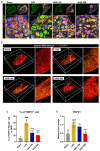Epidural Injection of Harpagoside for the Recovery of Rats with Lumbar Spinal Stenosis
- PMID: 37759506
- PMCID: PMC10526993
- DOI: 10.3390/cells12182281
Epidural Injection of Harpagoside for the Recovery of Rats with Lumbar Spinal Stenosis
Abstract
Epidural administration is the leading therapeutic option for the management of pain associated with lumbar spinal stenosis (LSS), which is characterized by compression of the nerve root due to narrowing of the spinal canal. Corticosteroids are effective in alleviating LSS-related pain but can lead to complications with long-term use. Recent studies have focused on identifying promising medications administered epidurally to affected spinal regions. In this study, we aimed to investigate the effectiveness of harpagoside (HAS) as an epidural medication in rats with LSS. HAS at various concentrations was effective for neuroprotection against ferrous sulfate damage and consequent promotion of axonal outgrowth in primary spinal cord neurons. When two concentrations of HAS (100 and 200 μg/kg) were administered to the rat LSS model via the epidural space once a day for 4 weeks, the inflammatory responses around the silicone block used for LSS were substantially reduced. Consistently, pain-related factors were significantly suppressed by the epidural administration of HAS. The motor functions of rats with LSS significantly improved. These findings suggest that targeted delivery of HAS directly to the affected area via epidural injection holds promise as a potential treatment option for the recovery of patients with LSS.
Keywords: epidural injection; harpagoside; inflammation; lumbar spinal stenosis; neuropathic pain; pain relief.
Conflict of interest statement
The authors declare no conflict of interest.
Figures







Similar articles
-
Repeated epidural delivery of Shinbaro2: effects on neural recovery, inflammation, and pain modulation in a rat model of lumbar spinal stenosis.Front Pharmacol. 2024 May 17;15:1324251. doi: 10.3389/fphar.2024.1324251. eCollection 2024. Front Pharmacol. 2024. PMID: 38828447 Free PMC article.
-
Correlation between severity of lumbar spinal stenosis and lumbar epidural steroid injection.Pain Med. 2014 Apr;15(4):556-61. doi: 10.1111/pme.12348. Epub 2014 Jan 16. Pain Med. 2014. PMID: 24433526
-
Understanding whether chronic lower back pain patients with lumbar spinal stenosis benefit from multiple epidural steroid injections prior to the mild® Procedure.Pain Manag. 2022 Apr;12(3):261-266. doi: 10.2217/pmt-2021-0093. Epub 2021 Nov 9. Pain Manag. 2022. PMID: 34751594
-
Epidural injections with or without steroids in managing chronic low back pain secondary to lumbar spinal stenosis: a meta-analysis of 13 randomized controlled trials.Drug Des Devel Ther. 2015 Aug 13;9:4657-67. doi: 10.2147/DDDT.S85524. eCollection 2015. Drug Des Devel Ther. 2015. PMID: 26316704 Free PMC article. Review.
-
Randomized trial of epidural injections for spinal stenosis published in the New England Journal of Medicine: further confusion without clarification.Pain Physician. 2014 Jul-Aug;17(4):E475-88. Pain Physician. 2014. PMID: 25054398 Review.
Cited by
-
Protective effects of harpagoside on mitochondrial functions in rotenone‑induced cell models of Parkinson's disease.Biomed Rep. 2025 Feb 11;22(4):64. doi: 10.3892/br.2025.1942. eCollection 2025 Apr. Biomed Rep. 2025. PMID: 39991000 Free PMC article.
References
Publication types
MeSH terms
Substances
LinkOut - more resources
Full Text Sources
Medical

